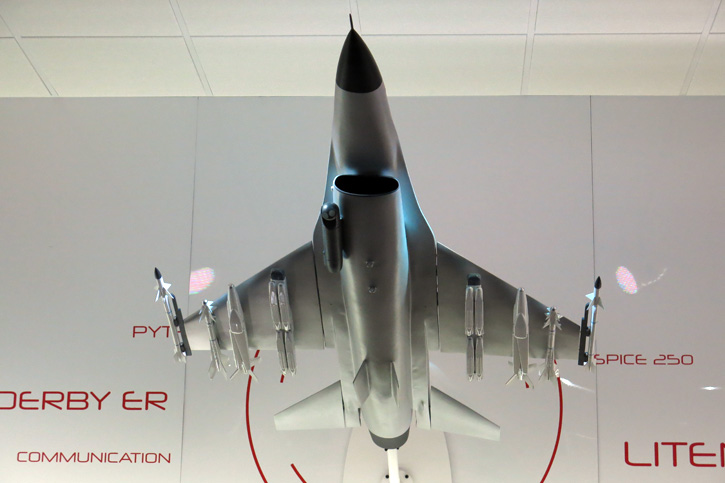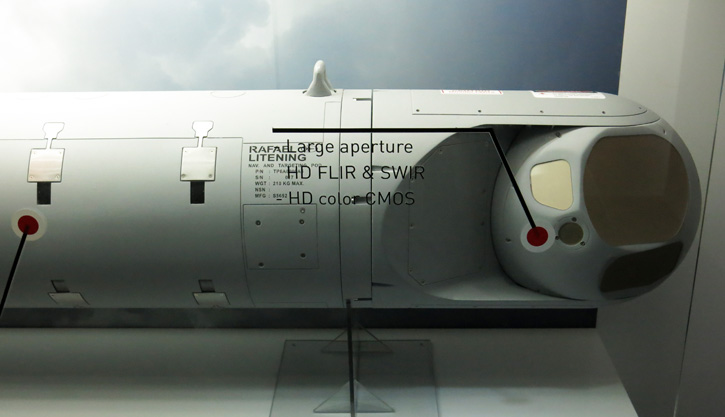
Coupling RAFAEL’s latest reconnaissance and targeting pods with scene matching EO guided weapons enables air forces to tighten targeting cycles from days and hours to few seconds.
RAFAEL is unveiling the Litening 5 at the Paris Air Show; the fifth generation of the targeting pod that defined this product category two decades ago is now capable of targeting from long range, enabling strike aircraft to employ guided weapons from standoff range without relying on external support.

Litening 5 employs a new sensor pack, utilizing an optical assembly and larger aperture tailored specifically for the new sensors, enabling the increased identification and recognition distance. The pod uses two FLIRS – a Mid-Wave Infra-Red (IR) and Short Wave IR (SWIR). The later extends observation range using active laser illumination. Complementing the sensor pack is a color CCD HD-TV, improving target recognition and separation of man-made objects that are often harder to spot in the thermal, monochromatic image. Color improves the ability to share a common understanding with ground forces and recognize specific vehicles based on their color. Images can be fused or displayed separately, based on the level of avionics used in the aircraft.
Rafael’s ‘image based common targeting language’ also known as Matchguide is integrated in the new pod, enabling rapid target handoff between the targeting pod, or ground-based forward air controller and guided weapons carried on board. Matchguide is fully integrated in the Litening 5, enabling the pilot or ground controller to designate a target simply by touching its image on a display, to deliver three-dimensional guidance cues as scene and image-based targeting for EO-guided weapons (Spice, for example) or as coordinates, to the attacking weapon – a method dramatically shortening the ‘sensor to shooter cycle’.

At the Paris Airshow RAFAEL is also introducing a new version of its tactical reconnaissance pod – RecceLite XR. This multi-spectral, multi-role, real time stand-off reconnaissance system consisting of an airborne pod, a wide digital datalink, and a ground exploitation station.
Similar to the Litening 5, Reccelite XR received an enhanced sensor package comprising megapixel-size arrays of Near-Infra-Red (NIR), MWIR, panchromatic (color) sensors and SWIR. As with the Litening 5, SWIR adds a significant long-range performance, since its spectral band is the least affected by atmospheric absorption. The gimbaled payload enables stabilized photography, irrespective of aircraft maneuvers or deviation from flight route.
Litening 5 and Reccelite XR share many common assemblies and modules and are carried by similar aircraft, thus contributing to efficient operation and lower life cycle support cost. Over 1,500 Litening targeting and navigation pods are currently flying on dozens of platform types with +25 air forces worldwide. RecceLite is in operational service with 10 air forces.
Meanwhile, Rafael’s US partner, Northrop Grumman has delivered the 500th AN/AAQ-28(V) LITENING G4 targeting pod to the United States military, marking an important milestone as forces worldwide continue to transition their LITENING pods to G4 configuration.
LITENING G4 offers advanced 1K sensors, laser imaging and advanced image processing. Recent tests in the USA also included an integration of color imaging camera, as used in the Litening 5. Northrop Grumman has also designed a derivative of the Litening, fitted with an Infra-Red Search & Track (IRST) from Selex. This derivative is addressing the US Air Forces’ capability requirement set by the US Air Force for F-15C/D upgrades.




















